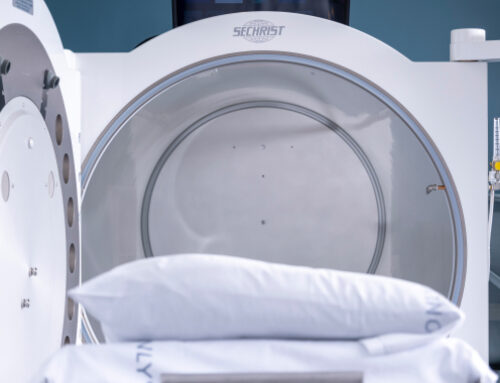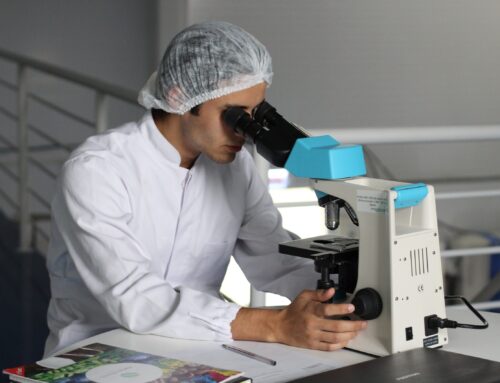There has been some growing interest in soft-side HBOT chambers because they are essentially inflatable or portable hyperbaric chambers that can be set up in one’s own home.
However, these soft chambers (sometimes called mild chambers) are NOT medical devices, are not rated to acceptable engineering standards, and don’t provide the same benefits that patients can receive in a hard chamber.
Let’s take a closer look at both these chambers to understand what makes them so different.
Hard HBOT Chambers
Hard monoplace and multiplace chambers are – as the name suggests – mechanically engineered and constructed out of hard materials to handle pressures up to 3.0 atmospheres.
HBOT works by exposing the patient to 100% pure oxygen in an environment where the atmospheric pressure can be precisely increased and controlled. While the patient relaxes in the monoplace chamber, the pressure is gradually increased to 2.4 – 3.0 ata, which makes it possible to saturate the body with oxygen.
We can measure the amount of oxygen the body is receiving my analyzing the arterial blood gases. At this pressure, the arterial blood oxygen can reach 1,737 mmHg. That is much higher than the 159mmHg we get at normal air pressure.
Multiplace chambers work a little differently, but with the same general purpose. However, instead of breathing pure oxygen in a pressurized chamber, patients sit in chambers filled with room air and breathe the oxygen through a hood or a mask. (These chambers are usually found in hospitals or trauma centers where fast responses are necessary to treat an emergency.)
In summary, hard-side HBOT chambers:
- Deliver 100% pure oxygen
- Can effectively stimulate wound healing
- Have countless case studies backing up the science
- May be covered by insurance
- Pipe oxygen directly into the chamber from a liquid oxygen tank so there’s no chance of contaminated air
- Can provide dozens of off-label treatments on top of the FDA-approved treatments
Speaking of FDA approved treatments, hard HBOT chambers are medical tools for treating:
- Air/gas embolism (bubbles in your blood vessels)
- Anemia
- Burns
- Carbon monoxide poisoning/Smoke inhalation
- Diabetic foot ulcers
- Decompression sickness
- Gangrene
- Infections (in the skin or bone)
- Ischemia (inadequate blood supply to parts of the body)
- Severe anemia
- Skin grafts and flaps that could suffer tissue death
- Non-healing wounds
Hard HBOT chambers can also help with some off-label conditions, including:
- Alzheimer’s treatment
- Arthritis treatment
- Cosmetic surgery recovery
- Dementia treatment
- Depression treatment
- Migraine treatment
- Psoriasis treatment
- Stroke treatment
The Soft-Side Hyperbaric Oxygen Chambers
A soft hyperbaric oxygen chamber is very different from hard chambers, and cannot provide the same benefits or treat the same conditions listed above.
These chambers are called soft because they are typically made out of some type of plastic that cannot stand up to the kind of pressures necessary to effectively saturate the body with oxygen.
A person does not need a physician’s recommendation or signature to use a soft chamber. In fact, it’s possible to buy a mild chamber and set it up inside your own home. This is what has generated the recent interest in these chambers, and many people are hoping to reap some of the HBOT benefits at home without any professional supervision or established procedures.
However, the truth is that these chambers are only approved for patients with acute mountain sickness.
That’s it.
While hard-side chambers can use 100% oxygen at up to 3.0 ata, a mild chamber has very limited applications because it uses compressed air that can’t achieve pressures over 1.3 ata. It can only produce around 24% oxygen, which means arterial oxygen levels of 197mmHg. That’s not much more than the 157mmHg you get at normal air pressure.
So, let’s sum it up. With soft-side hyperbaric oxygen chambers, you get:
- Ambient air (approximately 21% oxygen and a lot more nitrogen)
- Pressurized air that tops out at 1.3 ata
- No evidence for wound healing ability or antibacterial properties
- No supported from insurance companies
- Potentially contaminated air in the chamber
- More required sessions because of the lower levels of pressure and oxygen
- A chamber that is not designed to handle 100% oxygen
Our HBOT Chambers
At Aalto Hyperbaric Medical Group, our monoplace hyperbaric chambers are made by Sechrist Industries Inc., a world leader in HBOT technology. Each of these chambers has been designed to provide quality treatments in a comfortable environment.
Quality, Reliable Treatments with Hard-Side HBOT Chambers
Soft-side chambers may be more affordable, but there is certainly no evidence that they can provide the benefits and therapeutic value of a hard-side chamber.
There is simply no substitute for a high-tech HBOT chamber that has been mechanically engineered to deliver 100% pure oxygen and a staff that has been trained to make sure every session is as effective as possible.
RELATED POSTS
GET STARTED TODAY
Schedule an appointment with us today by calling (310) 507-7942 or using the contact form below.discover thisread what he saidelfbar 3500company website


